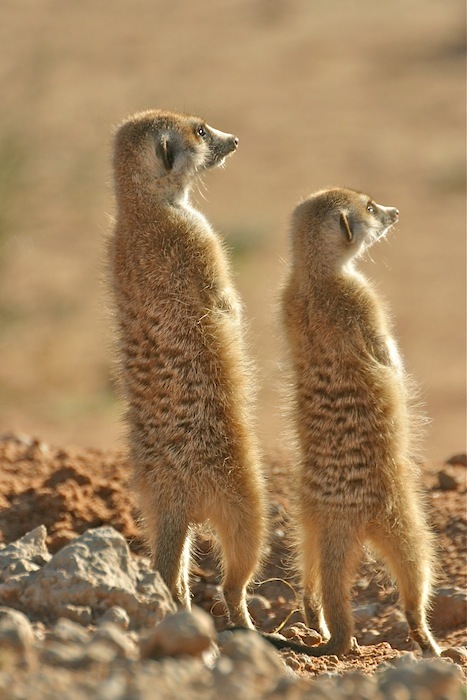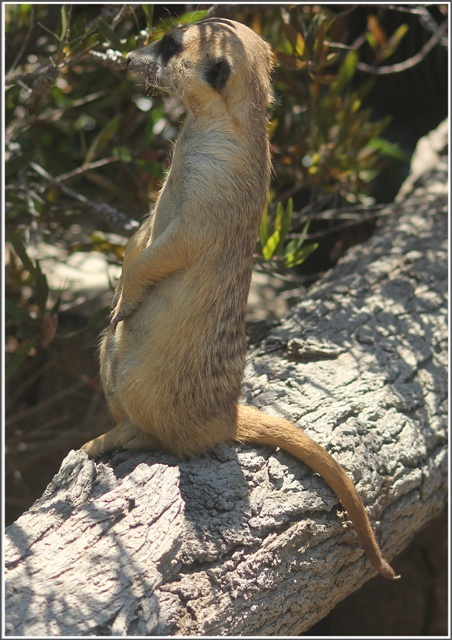Meerkat
- Amoli
- Posts: 6032
- Joined: Fri Jun 01, 2012 4:30 am
- Country: South Africa
- Location: Kempton Park
- Contact:
- nan
- Posts: 26474
- Joined: Thu May 31, 2012 9:41 pm
- Country: Switzerland
- Location: Central Europe
- Contact:
Re: Meerkat - Animal of the Month - August 2013
cute 

Kgalagadi lover… for ever
https://safrounet.piwigo.com/
https://safrounet.piwigo.com/
Re: Meerkat - Animal of the Month - August 2013
Thanks for your comments Lisbeth, nan, Flutterby, and Tshukudu. Yep, I love the lil' "chillin' out on the front porch" squirrel too.
Amoli, your photo is perfect for the next entry about meerkat behavior. Thanks!
Amoli, your photo is perfect for the next entry about meerkat behavior. Thanks!
Re: Meerkat - Animal of the Month - August 2013
Social Structure
Meerkats have a matriarchal society, with adult females generally slightly larger than the males. They live in clans (also called gangs or mobs) of usually five to thirty members. A gang is composed of a dominant female and male, known as the alpha female and alpha male, subordinate adults, known as beta females and beta males, and pups. Beta females and males, defined as any adult meerkat other than the leaders, usually leave the gang by the age of three.
Meerkats forage for most of the day, perhaps stopping in the shade or a burrow during the hottest hours. They have developed a way to forage in relative safety: adults take turns acting as guard while the others can look for food without worries. The guard climbs to the highest rock, termite mound, or bush he or she can find, stands upright on two legs, and then announces the beginning of guard duty with a specialized call.

In addition to taking turns as guard, meerkats also share the duty of raising the pups and teaching them how to hide, hunt, clean, and defend all that is theirs.

The mother needs to spend time foraging to supply her pups with milk, so other females and males stay behind to care for and protect her young. The mob may sometimes decide to move to a different burrow, and these "babysitters" help transport the pups, carrying them by the scruff of the neck. The more babysitters there are, the greater the survival rate for the pups.
Meerkats have a matriarchal society, with adult females generally slightly larger than the males. They live in clans (also called gangs or mobs) of usually five to thirty members. A gang is composed of a dominant female and male, known as the alpha female and alpha male, subordinate adults, known as beta females and beta males, and pups. Beta females and males, defined as any adult meerkat other than the leaders, usually leave the gang by the age of three.
Meerkats forage for most of the day, perhaps stopping in the shade or a burrow during the hottest hours. They have developed a way to forage in relative safety: adults take turns acting as guard while the others can look for food without worries. The guard climbs to the highest rock, termite mound, or bush he or she can find, stands upright on two legs, and then announces the beginning of guard duty with a specialized call.

In addition to taking turns as guard, meerkats also share the duty of raising the pups and teaching them how to hide, hunt, clean, and defend all that is theirs.

The mother needs to spend time foraging to supply her pups with milk, so other females and males stay behind to care for and protect her young. The mob may sometimes decide to move to a different burrow, and these "babysitters" help transport the pups, carrying them by the scruff of the neck. The more babysitters there are, the greater the survival rate for the pups.
- nan
- Posts: 26474
- Joined: Thu May 31, 2012 9:41 pm
- Country: Switzerland
- Location: Central Europe
- Contact:
Re: Meerkat - Animal of the Month - August 2013
Amoli and Exfmem thank you for pictures and info 

Kgalagadi lover… for ever
https://safrounet.piwigo.com/
https://safrounet.piwigo.com/
- Mel
- Global Moderator
- Posts: 26737
- Joined: Sat May 19, 2012 12:31 pm
- Country: Germany
- Location: Föhr
- Contact:
Re: Meerkat - Animal of the Month - August 2013
Agree! ExFmem puts a lot of effort in here to educate us.  Thanks for that, ExFmem
Thanks for that, ExFmem 
God put me on earth to accomplish a certain amount of things. Right now I'm so far behind that I'll never die.
Re: Meerkat - Animal of the Month - August 2013
It's easy to get engrossed in these little cuties. Thanks to all for following along 



